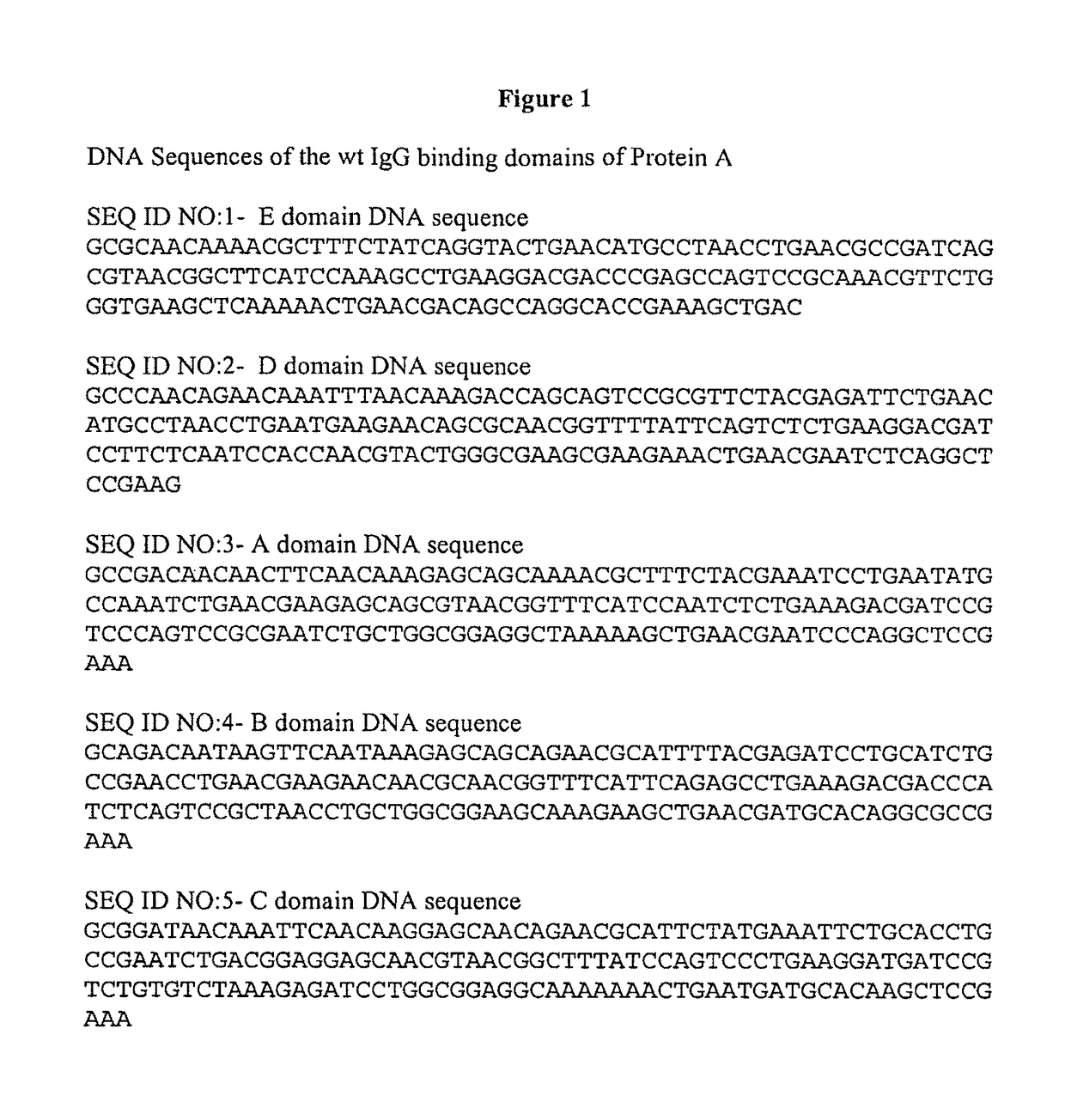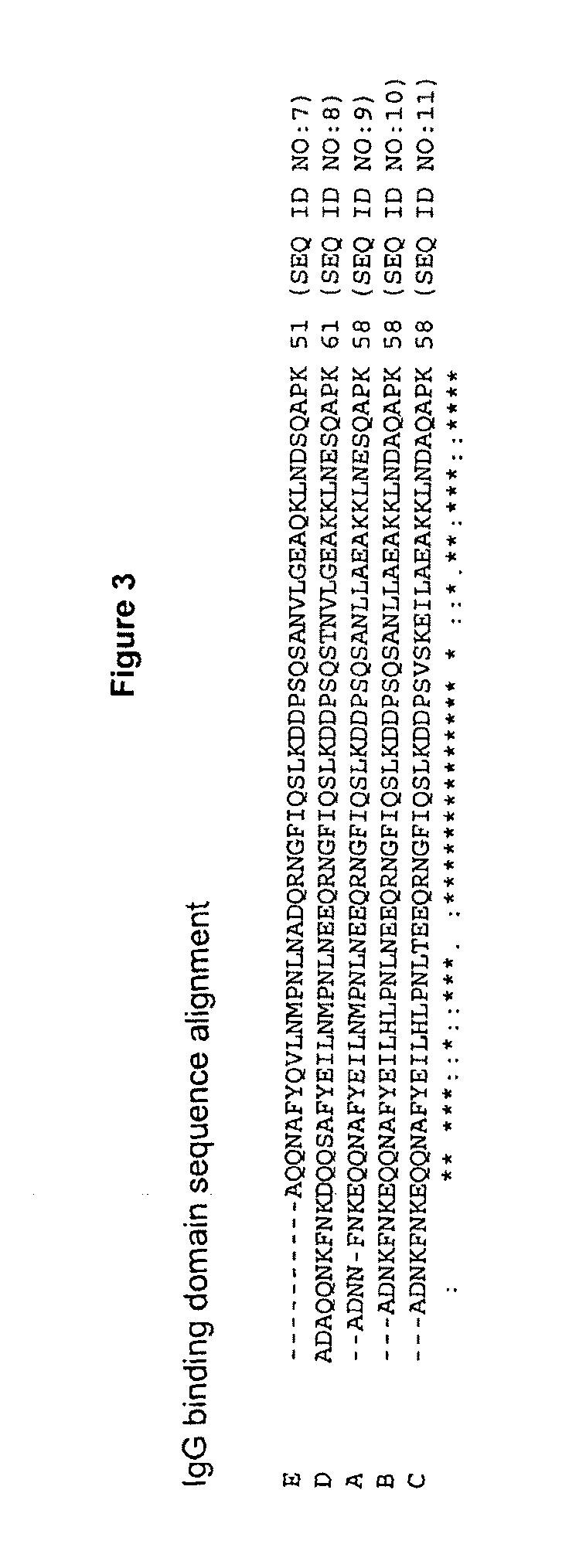Caustic stable chromatography ligands
a chromatography ligand, stable technology, applied in the field of chromatography ligands, can solve the problems of undesirable hard treatment and achieve the effect of cost-effectiveness
- Summary
- Abstract
- Description
- Claims
- Application Information
AI Technical Summary
Benefits of technology
Problems solved by technology
Method used
Image
Examples
example 1
n of an SpA B Domain Variant Having an n+1 Mutation, where n Represents an Asparagine
[0104]In an exemplary experiment, a synthetic gene encoding the “B domain” of protein A is obtained from DNA 2.0 (Menlo Park, Calif.). The 5′ end of the gene includes a codon for an initiating methionine as well as six histidine codons at the 3′ end of the gene. The gene is provided in vector pJ56:8620 from DNA 2.0. The parent vector pJ56 confers resistance to ampicillin, kanamycin, chloramphenicol and gentamicin. Appropriate restriction enzyme sites for the subsequent cloning of the gene into expression vectors are introduced into the gene at both 5′ and 3′ ends. A plasmid map of the vector is shown in FIG. 5.
[0105]Saturation mutagenesis is subsequently used to mutate glutamic acid at position 24 to all other naturally occurring amino acids except cysteine (C), serine (S), alanine (A), glycine (g), asparagine (N), and glutamine (Q) by PCR-based methods using the Phusion High-Fidelity DNA polymerase...
example 2
the Expressed Proteins for Alkaline Stability
[0112]Affinity purified wildtype and mutant SpA his-tagged constructs described in Example 1 are diluted with MilliQ water or with NaOH to a final concentration of 1N and incubated for six hours at room temperature. Biorad Micro Biospin 6 gel filtration columns are used to neutralize and buffer exchange 50 μl of each sample into PBS. Total protein quantitation is accomplished using the Pierce MicroBCA assay and samples are diluted to 10 μg / ml in PBS for loading onto the ELISA plate. Approximately 200 μl (2 μg) of treated PrA is adsorbed to the wells of an ELISA plate for 2-24 hours at 37° C. Plates are blocked in Pierce Superblock Blocking Buffer in PBS (Superblock-PBS) for about 2 hours at room temperature. Approximately 200 μl of Sigma human gamma globulin diluted to 0.05 mg / ml in Superblock-PBS (10 μg) is added to each well of the plate and binding is allowed to proceed for about 1 hour at room temperature. Following three washes with ...
example 3
t of Wildtype SpA and SpA Variants to a Solid Support
[0116]Subsequent to the generation of the various SpA variants and identification of those which are caustic stable using one or more assays known in the art and those described in Example 2, the SpA variants are attached to a support, e.g., a solid support. In an exemplary experiment, agarose beads (Sepharose 4B) (GE Healthcare, Piscataway N.J.) are crosslinked using epichlorohydrin according to a previously described method (Porath and Fornstedt, J. Chromatography, 51:479 (1979)). The agarose beads are reacted with positively charged associative groups, e.g., cations, according to the following method: 50 mL of beads are added to 40 g of 75% wt glycidyl trimethylammonium chloride (GTMAC), 10 mL Milli-Q® water (Millipore Corp., Billerica, Mass.) and 1.67 g 50% wt sodium hydroxide. The reaction is shaken vigorously (>100 rpm) on a rotary shaker overnight at room temperature. The beads are then filtered and washed with three 100 mL...
PUM
| Property | Measurement | Unit |
|---|---|---|
| pH | aaaaa | aaaaa |
| temperature | aaaaa | aaaaa |
| temperature | aaaaa | aaaaa |
Abstract
Description
Claims
Application Information
 Login to View More
Login to View More - R&D
- Intellectual Property
- Life Sciences
- Materials
- Tech Scout
- Unparalleled Data Quality
- Higher Quality Content
- 60% Fewer Hallucinations
Browse by: Latest US Patents, China's latest patents, Technical Efficacy Thesaurus, Application Domain, Technology Topic, Popular Technical Reports.
© 2025 PatSnap. All rights reserved.Legal|Privacy policy|Modern Slavery Act Transparency Statement|Sitemap|About US| Contact US: help@patsnap.com



